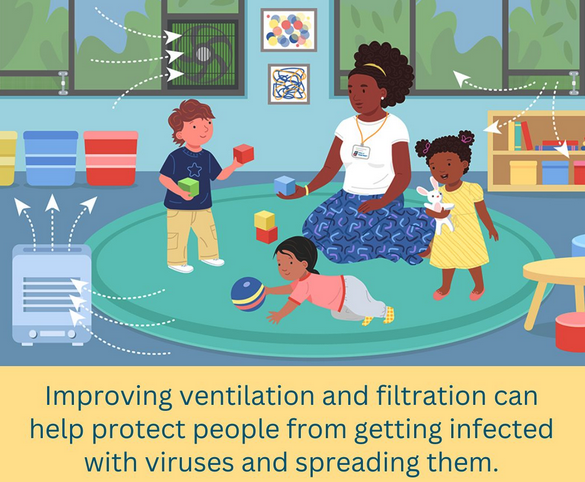The quality of the air we breathe affects the health and well-being of children, staff, and families. Indoor air can be improved with good ventilation that moves air in and out of buildings. Explore tips and strategies you can use at home and in buildings.
How does indoor air quality relate to children’s health?
Poor indoor air quality can affect children’s breathing, learning, and development.
Young children are sensitive to poor air quality, especially children with respiratory illnesses or chronic health conditions such as asthma.
Viral particles spread between people more easily indoors than outdoors.
Improving ventilation and filtration can help protect people from getting infected with viruses and spreading them.
What affects air quality?
Infectious disease
Smoke/wildfire smoke
Extreme heat
Air pollution
Mold and mildew
Pesticides
Cleaning products
Air fresheners
Perfume or fragrances
What is ventilation?
Ventilation moves fresh air into, out of, or within a room.
It also clears odors, germs, and other harmful particles from the air.
Ventilation reduces the number of viral particles in the air and lowers the risk of exposure to respiratory viruses.
What is filtration?
Filtration traps particles on a filter to remove them from the air.
It can also help prevent virus particles and smoke from accumulating in indoor air.
What strategies improve ventilation and filtration in homes and buildings?
Open windows, whether at home or in a building.
Opening windows allows fresh outside air to mix with indoor air. Opening windows and doors on opposite sides of the room creates cross-ventilation.
Safety tip: Windows that children can reach should open less than 4 inches or have a properly installed window guard.
Use fans.
Fans help mix the air within a room or move air from inside to outside and vice versa.
Free-standing fans can blow air away from people and increase the air flow in a room.
Fans safely secured in an open window or placed next to it blow the inside air out.
Ceiling fans move air upward or downward.
Bathroom and kitchen fans are usually exhaust fans that move air from inside to the outdoors.
Safety tip: Place fans to avoid creating a safety hazard. Make sure no one can trip over the cord, knock the fan over, touch the fan blades, or collide with the fan.
Make sure the heating, ventilation, and air conditioning (HVAC) system works properly.
Many buildings filter outdoor air and recirculate indoor air through an HVAC system. Work with a ventilation consultant when designing a new building, renovating, or upgrading a ventilation system. Maintain an HVAC system regularly as recommended by the manufacturer.
Air filters are part of an HVAC system. They block and catch small particles, making air healthier to breathe. You can gauge a filter’s effectiveness by checking its Minimum Efficiency Reporting Values (MERV) rating. Filters rated MERV 13 or higher are the most effective. Change filters regularly, according to the manufacturer’s instructions.
An HVAC professional should regularly check a building’s HVAC system to:
Make sure the air change per hour (ACH) is at least 5 ACH.
Adjust settings to bring inside as much outdoor air as possible, or to close the flow of air.
Perform regular maintenance.
If a building does not have an adequate HVAC system, a portable air cleaner with a filter can remove harmful particles in the air.
Check product information for the room size that the machine can clean, the particle size that the filter traps, and its clean air delivery rate (CADR). Use an air cleaner with a CADR that is at least two-thirds the square footage of the space.
Safety tip: Some electronic air cleaners (ionizers) create ozone as a byproduct. Breathing ozone has serious health risks. A mechanical air cleaner that pulls air through a filter is safer.
What strategies keep children safe?
Do not open windows if the outside air is unhealthy to breathe. If the air outside is polluted with smoke from fires or with pesticides from agricultural spraying, for example, it could trigger asthma or allergy symptoms or have other unhealthy effects. Check airnow.gov to see if the air quality is healthy.
Make sure portable fans are safe to use around children. If they are not safe, consider using them before children arrive, when children are playing outside, and at the end of the day after children are gone.
Keep portable air cleaners out of children’s reach by using barriers or protective screens.

